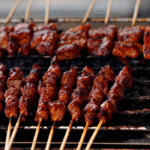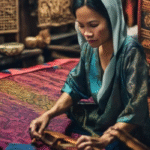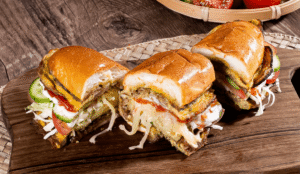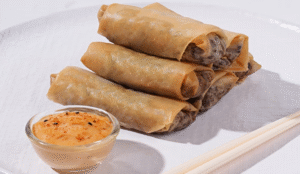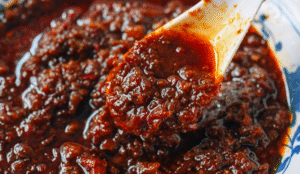Malaysian Heritage Food and Drink: The Flavors of Family Tradition
When you sit down at a Malaysian table, you’re never just eating. You’re tasting stories — generations of secrets, celebrations, struggles, and survival all woven into every bite. Our heritage food and drink are not just about flavor; it’s about belonging.
In this piece, we’ll wander through village kitchens, festive feasts, bustling kopitiams, and humble street stalls. We’ll explore Malaysia recipes passed down by grandmothers, discover the famous food of Malaysia, and savor the beauty of traditional Malaysian food that binds us together, plate by plate.
Frequently Asked Questions (FAQ)
1. What is the heritage food of Malaysia?
Malaysia’s heritage food is incredibly diverse — but some standout examples include:
Nasi Lemak (often called the national dish) — rice cooked in coconut milk, served with sambal, anchovies, egg, peanuts, and cucumber.
Rendang — slow-cooked spiced meat (often beef) originating from the Malay community.
Satay — skewered, grilled meat served with peanut sauce.
Laksa — spicy noodle soup with regional variations like Penang Asam Laksa or Sarawak Laksa.
Roti Canai — Indian-influenced flaky flatbread with dhal or curry.
Kuih-muih — colorful traditional cakes and sweets, deeply tied to Malaysian festivals.
These foods represent Malaysia’s multi-ethnic roots — Malay, Chinese, Indian, and indigenous communities.
2. What are some traditional foods in Malaysia?
In addition to those above, here are more beloved traditional foods:
Char Kuey Teow — wok-fried flat rice noodles with seafood and Chinese sausage.
Hainanese Chicken Rice — poached chicken with fragrant rice.
Teh Tarik — “pulled tea,” the national drink.
Cendol — shaved ice dessert with coconut milk, palm sugar, and green rice flour jelly.
Bah Kut Teh — herbal pork rib soup.
Ayam Percik — grilled spiced chicken with coconut sauce, common in Kelantan.
3. What role does food play in preserving cultural heritage?
Food is a living expression of cultural heritage — it:
Keeps traditional cooking methods alive (e.g., charcoal grilling, stone grinding spices).
Connects generations through family recipes.
Strengthens community bonds during festivals, weddings, or communal feasts.
Acts as an identity marker — certain dishes symbolize ethnic pride (e.g., Rendang for Malay, Nyonya kuih for Peranakan).
Becomes part of tourism — food is a gateway for visitors to understand culture.
4. Are traditional foods often passed down through generations as part of cultural heritage?
Yes, absolutely.
Many Malaysian families pass recipes and techniques by:
Oral storytelling.
Hands-on teaching in home kitchens.
Festive rituals — e.g., making ketupat for Hari Raya or mooncakes for Mid-Autumn Festival.
These foods become heirlooms, preserving identity and continuity.
5. What are the factors that shape Malaysian heritage cuisine?
Key factors:
Ethnic diversity: Malay, Chinese, Indian, indigenous (Kadazan-Dusun, Iban, Orang Asli).
Colonial influences: Portuguese, Dutch, British left traces (e.g., Devil Curry from the Portuguese Eurasian community).
Trade routes: Spices, tea, and culinary ideas spread via the Straits of Malacca.
Geography: Coastal, tropical climate = fresh seafood, tropical fruits, rice, coconut.
Religion & beliefs: Halal practices in Malay cooking; vegetarian elements in Indian cuisine.
Migration & fusion: Peranakan (Nyonya) cuisine blends Malay and Chinese methods.
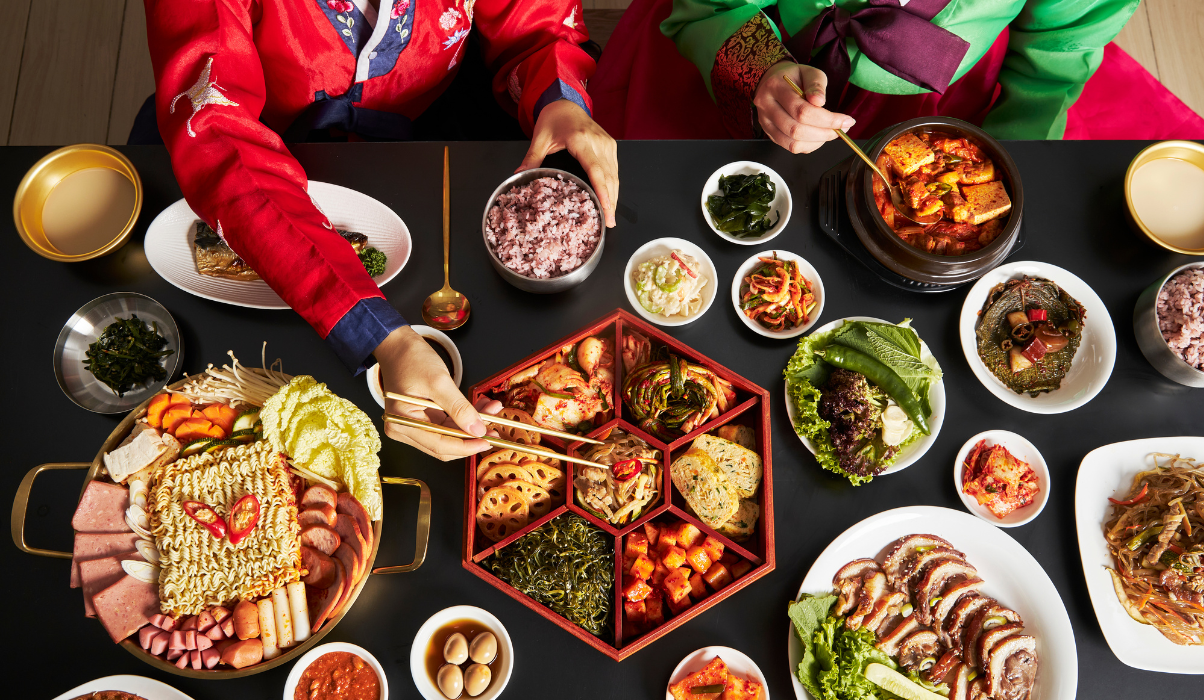
The Soul of Malaysia: Why Heritage Food and Drink Matter
Ask any Malaysian living overseas what they miss most, and 9 out of 10 times the answer is: Makan! Because our heritage food and drink isn’t just sustenance — it’s an emotional anchor.
This is why our heritage food and drink deserve more love today. Wherever you come from — Malay, Chinese, Indian, Kadazan, Iban, or mixed — you’ll find your story in the spice of a rendang, the sweetness of kuih, or the aroma of kopi kampung at dawn.
When families gather, food is the love language. The auntie who wakes at 4 AM to pound sambal belacan, the uncle who brings home banana leaves for wrapping lemang — they don’t just cook; they keep our cultural flame alive.
Flavours From The Kampung: Treasured Malaysia Recipes
In the heartlands, the essence of heritage food and drink lies in simple, timeless Malaysia recipes.
- Rendang Tok
A Perak classic, rendang tok is slow-cooked beef simmered for hours in coconut milk, spices, and kerisik (toasted coconut). Unlike regular rendang, it’s dry, spicy, and robust — a dish proudly served at weddings, Raya gatherings, or anytime you want to impress guests. - Nasi Dagang
A beloved East Coast breakfast, nasi dagang pairs rice steamed in coconut milk with rich tuna curry and pickled vegetables. Fishermen’s families created it for early mornings before heading out to sea — practical fuel turned national treasure. - Iban Pansuh
From Sarawak, pansuh is chicken cooked inside bamboo with wild ginger, tapioca leaves, and herbs. This traditional Malaysian food reflects the ingenuity of indigenous communities, who used what nature offered to infuse smoky, earthy flavors. - Nyonya Kuih
Who can resist the colorful trays of Nyonya kuih — sweet, sticky rice cakes layered with pandan, gula Melaka, and coconut? These little morsels are edible art, representing the Peranakan community’s blend of Chinese and Malay influences.
Each of these Malaysia recipes is more than taste — it’s tradition on a plate.
Street Food: Malaysia’s Living Heritage
If you want to see heritage food and drink alive in its most authentic form, head to the streets. Hawker stalls are our open-air museums. The sizzle of char kuey teow, the clink of teh tarik glasses, the hiss of satay on open flames — they’re the soundtrack of Malaysia’s culinary heartbeat.
Some iconic famous food of Malaysia born on these streets include:
- Roti Canai — An Indian Muslim staple, flaky flatbread flipped and twirled with theatrical flair, served with dhal or spicy curry.
- Nasi Lemak — Our unofficial national dish. Coconut rice, sambal, fried anchovies, peanuts, egg, and cucumber — cheap, filling, and a taste of home for every Malaysian.
- Char Kuey Teow — Flat rice noodles stir-fried in pork lard (in Penang’s version), tossed with prawns, Chinese sausage, bean sprouts, and a hint of wok hei — that smoky aroma you can’t fake.
- Teh Tarik — The national drink, literally “pulled tea.” Sweet, frothy, and perfectly balanced between creamy and strong.
You’ll find heritage food and drink at the heart of every Malaysian celebration. Our street food scene is where heritage food and drink stay alive through old recipes and new hands. Third-generation hawkers keep grandfather’s wok hot while adding their own tweaks, proving that heritage food and drink is never static — it evolves with every vendor and every hungry mouth.
Heritage Feasts: Food and Festival
When festive seasons arrive, Malaysia’s tables overflow with traditional Malaysian heritage food and drink — each festival with its own signature spread.
- Hari Raya Aidilfitri — After a month of fasting, families gather for rendang, lemang, ketupat, and kuah kacang. Children receive duit raya while plates are loaded again and again.
- Chinese New Year — Reunion dinners bring out yee sang (prosperity toss salad), steamed fish, roast duck, pineapple tarts, and tang yuan (sweet glutinous rice balls).
- Deepavali — Indian households prepare mutton curry, murukku, laddu, and colorful rice dishes like nasi briyani — each symbolizing light and abundance.
- Gawai and Kaamatan — In East Malaysia, harvest festivals mean rice wine (tuak), grilled wild boar, and pansuh chicken shared among longhouse families.
Food is the bridge that ties our spiritual life to daily life — that’s what makes heritage food and drink so much more than a meal.
The Drink Side: Local Brews and Nostalgic Sips
We can’t talk about heritage food and drink without the drinks! Some beverages are nearly as iconic as the dishes themselves.
Kopi Kampung — Thick, dark, sweetened with condensed milk. Kopitiams keep it alive — old uncles sip kopi and gossip under ceiling fans that spin too slowly.
Air Bandung — Pink rose syrup milk drink, always seen at Malay weddings and Ramadan bazaars. Sweet, fragrant, and unmistakably Malaysian.
Sirap Selasih — Rose syrup with basil seeds floating like tiny black pearls. It cools you down after a spicy feast.
Toddy — Less common today but still treasured in some communities, this fermented coconut sap drink has a long history, especially among rural Indian and Chinese Malaysians.
Family Tradition: The Secret Ingredient
Ask any grandma for her rendang or kuih recipe and she’ll say: agak-agak. There’s no measuring cup — it’s all feel, taste, and intuition. This “by heart” approach is why heritage food and drink tastes different in every house.
To truly appreciate Malaysia, you must taste its heritage food and drink. It’s not just about ingredients — it’s the act of cooking together. Grandchildren learn to stir a pot, wrap banana leaves, or peel onions while listening to old family stories. This transfer of knowledge is Malaysia’s real secret recipe.
Heritage Food and Drink in Modern Malaysia: Old Meets New
Malaysia’s food scene today is a mix of respect and reinvention. Young chefs, home bakers, and food truck owners take traditional Malaysian food and give it fresh twists.
Think nasi lemak burgers, durian crepes, or vegan rendang. Urban cafés serve deconstructed kuih or pair kampung-style rice with Western-style plating.
This innovation is vital. It keeps heritage food and drink relevant for the next generation. If a nasi lemak croissant convinces a teenager to learn their grandmother’s sambal recipe later — why not?
Preserving Heritage: The Role of Home Cooks and Hawkers
While restaurants and chefs play a role, the real heroes are families and hawkers who refuse to let old recipes fade.
Hawkers who still wake at 3 AM to grind spice pastes by hand. Aunties who roll pineapple tarts every CNY, even when it’s easier to buy from the supermarket. Rural folks who keep growing fresh herbs in backyard plots.
When we buy from these small makers, we’re investing in the survival of heritage food and drink.
Regional Gems: Malaysia’s Local Food Stories
Every state has its pride. Some lesser-known famous food of Malaysia worth highlighting:
- Sabah — Hinava (raw fish salad) is Kadazan-Dusun culinary pride, seasoned with lime, ginger, and bird’s eye chili. Pair it with rice wine for a real Sabahan experience.
- Sarawak — Sarawak Laksa’s spicy coconut broth is legendary. Many locals say “You haven’t been to Kuching if you haven’t slurped this!”
- Kelantan — Besides nasi kerabu, Kelantan boasts laksam — rice noodle rolls swimming in a creamy fish gravy, topped with fresh ulam.
- Negeri Sembilan — Famous for masak lemak cili api — fiery coconut curries that define the Minangkabau spirit.
Each region’s specialties remind us that Malaysia’s culinary map is as colorful as our people.
Learning From the Past: Recipe Books, Oral Tales, and Grandma’s Notes
Many Malaysia recipes were never written down. They lived in heads, hearts, and old yellowed notebooks. Today, more Malaysians are documenting them — food bloggers, YouTube cooks, even community recipe books that archive endangered dishes.
Next time your mom says “I don’t have it written down,” pull out your phone and record her cooking. One day, that might be your family’s culinary heirloom.
Tea Time: The Social Ritual
Some of Malaysia’s best heritage food and drink moments happen at tea time. Afternoon tea is a ritual — families gather around kuih trays, kopi, and conversation.
Kuih lapis, curry puffs, onde-onde — little bites with big memories. These small eats bridge generations, turning ordinary evenings into cherished moments.
The Future: Keeping Heritage Food and Drink Alive
With urban life and global fast food, it’s easy to take heritage food and drink for granted. But every bowl of laksa or cup of kopi kampung is a living piece of history.
Here’s how you can help keep it alive:
- Cook one Malaysia recipe your grandma made.
- Support local hawkers and small kuih sellers.
- Teach your kids the difference between fast food and real food.
- Try one new traditional Malaysian food each month.
- Celebrate your heritage — share stories, share recipes.
Deeper Dive: Why Heritage Food and Drink Matters So Much
In today’s fast-paced world, where food delivery apps and trendy fusion cafés tempt us with convenience, we sometimes forget the meaning behind heritage food and drink. It’s more than nostalgia — it’s an edible archive of migration, colonial history, trade routes, and family legacies.
For example, take laksa. One bowl of laksa reflects centuries of trade between Chinese immigrants, local Malay fishermen, and Indian spice traders. The coconut milk, lemongrass, belacan — each ingredient has a story rooted in our land and our people.
This is why many chefs and food historians are pushing to preserve old Malaysia recipes and the traditional ways they are cooked. Once they’re lost, they’re gone for good — replaced by shortcuts and generic flavors that don’t speak of our true roots.
Lesser-Known Heritage Dishes That Deserve Attention
We often talk about the famous food of Malaysia — nasi lemak, satay, char kuey teow. But our culinary heritage goes far beyond these crowd-pleasers. Here are a few hidden gems you might not know but absolutely should:
- Perut Ikan — A spicy Nyonya dish made with pickled fish stomach, aromatic herbs, torch ginger flower, and vegetables. It’s tangy, complex, and labor-intensive — a dish that’s slowly disappearing because few have the patience to make it.
- Linut (Sagu)— A gooey, sticky sago porridge eaten by the Melanau people in Sarawak. It’s dipped in sambal belacan — simple, filling, and deeply tied to local sago palm traditions.
- Tempoyak Ikan Patin — A Pahang favorite where catfish is cooked in fermented durian sauce. For some, it’s an acquired taste; for locals, it’s comfort food that reminds them of family riverside feasts.
- Kerabu — Various states have their own take on this herbal salad. In Kelantan, kerabu pucuk paku (fern shoot salad) is iconic. It shows how rural communities turned wild edible plants into zesty, refreshing sides.
By spotlighting these unsung heroes of our heritage food and drink, we help ensure they’re not overshadowed by more commercial dishes.
Cooking As Community: Village Gatherings and Gotong-Royong
One beautiful aspect of heritage food and drink is the communal spirit behind it. In kampungs, cooking large meals is often a gotong-royong affair — everyone pitches in.
During weddings or kenduri (feasts), you’ll see uncles chopping onions, aunties stirring giant woks of curry, kids folding ketupat leaves. It’s not just about efficiency — it’s a ritual that brings the community together.
These scenes are disappearing in urban life, where caterers and delivery food are more practical. But in villages and smaller towns, this practice continues to nurture bonds that no fancy buffet can replace.
From Market to Table: The Role of Pasar Pagi
No conversation about heritage food and drink is complete without the humble pasar pagi (morning market).
In these bustling markets, you’ll find the freshest ingredients — jungle ferns, banana leaves, turmeric roots, bunga kantan (torch ginger), belacan blocks wrapped in newspaper. These markets are more than just shopping spots; they are social hubs where people exchange recipes, cooking tips, and gossip.
Elders swear by wet markets because only there can they find the quality and freshness needed for authentic Malaysia recipes.
Grandmother’s Secrets: How Heritage Food is Passed Down
Have you ever tried to write down a family Malaysia recipe? It’s almost impossible! Mak Tok might say, “Letak garam sikit je…” (Just a bit of salt). But “sikit” for her might be a whole handful!
This intuitive cooking style means every household’s version of the same dish tastes slightly different. That’s what makes our heritage food and drink so personal — rendang in one house could be spicier than in another; grandma’s kuih might be softer than your neighbor’s.
More families are starting to record these oral recipes so the next generation doesn’t lose them to time. Digital cookbooks, food vlogs, and handwritten recipe journals are precious efforts to safeguard this living legacy.
Final Thoughts: More Than a Meal
Malaysia’s heritage food and drink is our identity, history, and future — all wrapped in banana leaves, simmered in clay pots, or sipped from a steaming kopi cup.
Every time you sit down for rendang, kuih, or kopi kampung, remember: you’re part of a long, delicious story that connects us all.
So cook it, share it, eat it — and keep our heritage alive, one bite at a time. Every family table is a tribute to Malaysia’s heritage food and drink.

